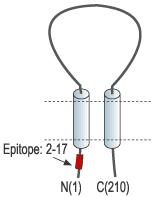Overview
- Peptide AKLRVSYEYTEAEDKS(C), corresponding to amino acid residues 2-17 of rat KCNMB4 (Accession Q9ESK8). Intracellular, N-terminal part.

 Western blot analysis of rat brain membranes:1. Anti-sloβ4 (KCNMB4) Antibody (#APC-061), (1:200).
Western blot analysis of rat brain membranes:1. Anti-sloβ4 (KCNMB4) Antibody (#APC-061), (1:200).
2. Anti- sloβ4 (KCNMB4) Antibody, preincubated with sloβ4/KCNMB4 Blocking Peptide (#BLP-PC061).- Human detrusor smooth muscle (DSM) cells (1:200) (Hristov, K.L. et al. (2011) Am. J. Physiol. 301, C903.).
 Expression of KCNMB4 in rat hippocampus and cortex
Expression of KCNMB4 in rat hippocampus and cortexImmunohistochemical staining of perfusion-fixed frozen rat brain sections with Anti-sloβ4 (KCNMB4) Antibody (#APC-061), (1:200), followed by goat-anti-rabbit-AlexaFluor-488. A. KCNMB4 staining (green) in rat hippocampal CA1 region is detected in apical dendrites (arrows) of pyramidal neurons from the pyramidal layer (PL). B. Staining in rat parietal cortex shows staining of apical dendrites (arrows) of pyramidal neurons. Cell nuclei are stained with DAPI (blue).
- Rat brain sections (1:50) (Piwonska, M. et al. (2008) Neuroscience 153, 446.).
- Human detrusor smooth muscle (DSM) cells (1:100) (Hristov, K.L. et al. (2011) Am. J. Physiol. 301, C903.).
- Meera, P. et al. (2000) Proc. Natl. Acad. Sci. U.S.A. 97, 5562.
- Orio, P. et al. (2002) News Physiol. Sci. 17, 156.
- Brenner, R. et al. (2000) J. Biol. Chem. 275, 6453.
sloβ4 is a member of a family of regulatory β subunits that control the activity of the large conductance Ca2+-activated K+ channel, KCa1.1. The family includes four members with a shared topology: two transmembrane domains, short intracellular N- and C-termini and a large extracellular region.
The four members of the family have a distinct tissue distribution with sloβ4 expressed almost exclusively in the central nervous system (CNS).
Functionally, sloβ4 increases the sensitivity of the pore-forming KCa1.1 subunit to Ca2+ and voltage and it also changes its pharmacology. It has been shown that co-expression of sloβ4 with KCa1.1 makes the latter resistant to nanomolar concentrations of the well-known inhibitors charybdotoxin and iberiotoxin.
The physiological significance of sloβ4 expression in the CNS is not clear, but KCa1.1 channels are likely involved in the regulation of neurotransmitter release in presynaptic terminals.
Application key:
Species reactivity key:
Alomone Labs is pleased to offer a highly specific antibody directed against an epitope of rat sloβ4. Anti-sloβ4 (KCNMB4) Antibody (#APC-061) can be used in western blot, immunocytochemistry, and immunohistochemistry applications. It was designed to recognize sloβ4 from human, rat, and mouse samples.
Applications
Citations
- Human dermal fibroblasts (1:200).
Kicinska, A. et al. (2016) Biochem. J. 473, 4457. - Mouse olfactory bulb lysate.
Gorin, M. et al. (2016) J. Neurosci. 36, 3127. - Human U-87 MG cell lysate (1:200).
Bednarczyk, P. et al. (2013) PLoS ONE 8, e68125. - Human detrusor smooth muscle (DSM) cells (1:200).
Hristov, K.L. et al. (2011) Am. J. Physiol. 301, C903.
- Mouse olfactory bulb sections (1:100).
Gorin, M. et al. (2016) J. Neurosci. 36, 3127. - Rat brain sections (1:50).
Piwonska, M. et al. (2008) Neuroscience 153, 446.
- Rat pinealocytes.
Mizutani, H. et al. (2016) Am. J. Physiol. 310, C740. - Human detrusor smooth muscle (DSM) cells (1:100).
Hristov, K.L. et al. (2011) Am. J. Physiol. 301, C903.
- Cornelius, R.J. et al. (2012) Am. J. Physiol. 303, F1563.
- Yang, C. et al. (2011) Proc. Natl. Acad. Sci. U.S.A. 108, 19419.
- Akerman, S. et al. (2010) Pain 151, 128.
- Holtzclaw, J.D. et al. (2010) Am. J. Physiol. 299, F507.
- Wulf-Johansson, H. et al. (2010) Neuroscience 167, 1091.
- Chen, M. and Petkov, G.V. (2009) J. Urol. 182, 374.
